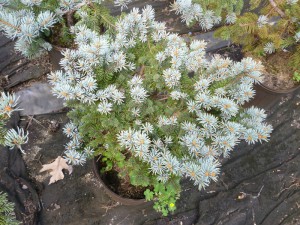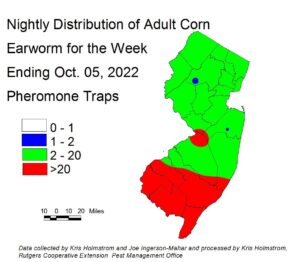Archives for October 2022
NEW: Rutgers Private Applicator 2023 Online License Renewal Assistance Available Daily Until October 31st!
Hill-Up your Grapevines to Prevent Winter Injury
Freeze injury on grape flower buds and canes can cause crop loss and increased disease problems, but freeze damage at the graft union can kill the entire vine! The most effective technique for limiting freeze injury to the graft union is hilling up soil around the vines high enough to cover the graft union with 3 to 4 inches of soil. This practice is especially important for vines less than 5 years old. Now, before temperatures drop and the ground freezes is the time to get out there and hill up your vines. Factsheet 1264 https://njaes.rutgers.edu/fs1264/ details the following important aspects of hilling-up to protect the graft union from cold damage.
 The principle of Hilling-up – How the soil works, both as a thermal mass that holds the heat and an insulator that slows heat loss.
The principle of Hilling-up – How the soil works, both as a thermal mass that holds the heat and an insulator that slows heat loss.- How to perform effective hilling-up using available and specialized implements.
- Cost benefits of using the implements.
- Challenges such as timing, preventing damage to the drip lines and trunks during hilling-up; and how to address those challenges.
- The process of hilling down in the spring to prevent root formation above the graft union and proper weed management.
NJ BPU Asking for Participation in Broadband Access Study Commission Survey
THE FOLLOWING MESSAGE IS FROM THE NJ DEPT OF AGRICULTURE ON BEHALF OF NJ SECRETARY OF AGRICULTURE DOUGLAS FISHER
The New Jersey Bureau of Public Utilities (BPU), in accordance with the New Jersey Broadband Access Study Commission – established by the state of New Jersey Legislature this past March, has engaged ECC Technologies, Inc., to complete a comprehensive broadband focused project in New Jersey. Among other things, the project addresses broadband infrastructure and service, and includes a survey to identify broadband availability.
We especially encourage state agricultural producers to participate in this project.
Read the full press release at https://bit.ly/3VlwvcU.
Find the survey at www.broadband-nj.com.
Autumn Pest Review: Soft Scales, Leafminers, Aphids, Mites & Adelgids
AUTUMN PEST REVIEW: Although the season is beginning to wind-down, there are still a number of insect & mite pests that require scouting during the fall weeks. The pests discussed in this blog include soft scale nymphs, boxwood leafminers, white pine aphids, spruce spider mites, southern red spider mites, hemlock rust mites, eastern spruce gall adelgids & hemlock woolly adelgids. The use of low %-rates of horticultural oils this fall can be especially valuable against controlling many of these pests.
SOFT SCALE NYMPH MIGRATIONS: Most soft scale species (exceptions include magnolia, tuliptree, and globose) have 1st instar nymphs that spend July and August feeding along veins on the undersides of leaves of their deciduous host (the use of a hand lens may be needed). During the weeks of late summer and early fall, these nymphs migrate off the leaves onto woody stem tissue and molt into the overwintering 2nd instar stage. The size of the nymphs increases 3-times after molting and their presence is usually observable even without magnification (they can be as large as lenticels). Typically, overwintering soft-scale nymphs have a dark coloration, to help absorb sunlight and maintain body warmth.
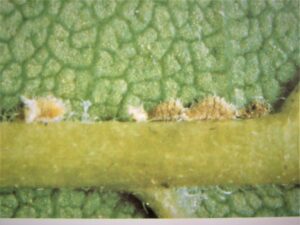
European elm 1st-instar nymphs settled along the main vein underneath elm leaf. During the early weeks of fall they migrate from leaves onto the bark to overwinter. (Photo Credit: Cornell University)
Why Do Spruce Christmas Trees Show Interior Needle Discoloration?
Occasionally, observations of White Spruce (Picea glauca) or Colorado Spruce (Picea pungens) within landscapes, nurseries, & Christmas tree farms will show current needle growth having a blue or blue-green color, but with older, inner needles having lost the desirable color and turning pale or even yellow. Although sometimes seen on Norway Spruce, these symptoms are most common on the White & Colorado Spruce species. Sometimes symptoms can become dramatic and initiate both aesthetic and plant health concerns. Although the reasons for such symptoms can be from a complex number of conditions, a compromised root system is typically the underlying cause.
Vegetable IPM Update 10/05/22
Note: This IPM Update is the final scheduled one of the season. Specific updates will be published as necessary.
Sweet Corn
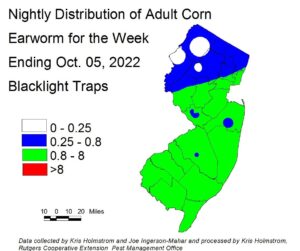 Corn earworm (CEW) moth captures from both blacklight traps and pheromone traps have declined dramatically with prolonged cool night temperatures. It is difficult to say if there is a larger moth population around that is simply not active. The near term forecast is for cold nighttime temperatures, so we may not experience much in the way of CEW moth activity as we close out the sweet corn season. Pheromone traps in northern Burlington County and Cape May County are highest at this time. Both trap types are in general agreement as to spray schedules. CEW populations can increase or decline with changes in night temperatures. The number of pheromone traps deployed is much lower, resulting in much broader color bands on the map. It is also important to understand that pheromone traps are more sensitive than blacklight traps, and thresholds are adjusted to account for the higher catches typical of this trap type. Remaining silking corn is at risk of CEW infestation at this time. On the blacklight map (left), green areas represent a 3-day silk spray schedule, while blue is a 4-5 day schedule. On the pheromone map (below right), red represents a 3-day spray schedule, green represents a 4-day schedule. Be sure to access information from this publication in the upcoming weeks to determine how frequently you should treat silking sweet corn to protect it from CEW infestation.
Corn earworm (CEW) moth captures from both blacklight traps and pheromone traps have declined dramatically with prolonged cool night temperatures. It is difficult to say if there is a larger moth population around that is simply not active. The near term forecast is for cold nighttime temperatures, so we may not experience much in the way of CEW moth activity as we close out the sweet corn season. Pheromone traps in northern Burlington County and Cape May County are highest at this time. Both trap types are in general agreement as to spray schedules. CEW populations can increase or decline with changes in night temperatures. The number of pheromone traps deployed is much lower, resulting in much broader color bands on the map. It is also important to understand that pheromone traps are more sensitive than blacklight traps, and thresholds are adjusted to account for the higher catches typical of this trap type. Remaining silking corn is at risk of CEW infestation at this time. On the blacklight map (left), green areas represent a 3-day silk spray schedule, while blue is a 4-5 day schedule. On the pheromone map (below right), red represents a 3-day spray schedule, green represents a 4-day schedule. Be sure to access information from this publication in the upcoming weeks to determine how frequently you should treat silking sweet corn to protect it from CEW infestation.
The highest nightly blacklight trap catches of CEW for the week ending 10/05/22 are as follows:
| Downer 6 | New Egypt 2 | Hackettstown 1 |
| Crosswicks 3 | Chester 1 | Long Valley 1 |
| Georgetown 3 | Cinnaminson 1 | Port Murray 1 |
| East Vineland 2 | Denville 1 | Tabernacle 1 |
The highest nightly pheromone trap catches of CEW for the week ending 10/05/22 are as follows:
| Green Creek 63 | Georgetown 25 | Matawan 3 |
| East Vineland 34 | Springdale 17 | Chester 2 |
| Folsom 28 | Allamuchy 14 | Farmingdale 2 |
| Eldora 24 | Tabernacle 6 |
Silking Spray Schedules*:
South – 3 days
Central – 3 days
North – 4-5 days
*These recommendations are based on regional catches. Adhere to tighter spray schedules if indicated by local trap catches. Synthetic pyrethroids alone should NOT be used for corn earworm (CEW) protection on silking corn, or for fall armyworm (FAW) management at any stage. Control with these materials is very inconsistent. Utilize materials in IRAC groups 5 and 28, or combination products that include IRAC group 28 for best control. See the Sweet Corn section of the 2020-21 Commercial Vegetable Production Guide for selections.
Beet armyworm adults (BAW) continue to be captured over the past week. Nightly counts include:
| East Vineland 10 |
Growers in Gloucester, Salem and Cumberland counties should monitor pepper fields weekly for signs of feeding. BAW larvae (photo at left) feed in the developing foliage in terminal growth of plants. Initially, leaves are skeletonized, but as larvae grow, they will move onto fruit and damage these as well. 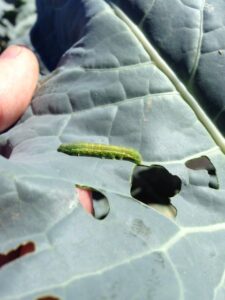 BAW is also impacting spinach and other greens in southern counties. Injury to crops such as beet tops, swiss chard and spinach can be extreme. As with other armyworms, BAW is difficult to control with pyrethroid insecticides. Effective materials include spinosyns (IRAC 5) and diamides (IRAC 28).
BAW is also impacting spinach and other greens in southern counties. Injury to crops such as beet tops, swiss chard and spinach can be extreme. As with other armyworms, BAW is difficult to control with pyrethroid insecticides. Effective materials include spinosyns (IRAC 5) and diamides (IRAC 28).
Pumpkins and Winter Squash
Populations of melon aphids are present in some pumpkin and winter squash fields (see photo below at left). This pest has the ability to increase to extremely high population levels in fields. When this happens, their sticky droppings are deposited on fruit below the canopy. Sooty 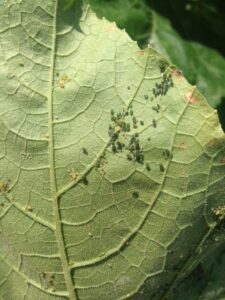 mold fungus grows on this sticky coating, disfiguring fruit. Additionally, hornets are attracted to the aphid droppings; creating a potential issue in U-pick situations. Check fields weekly for the presence of melon aphid colonies developing on the undersides of leaves. If aphids are found in more than one sample site/10 sites, consider an insecticide application to limit population spread. There are a number of effective materials listed in the Pumpkin and Winter Squash section of the 2022-23 Commercial Guide. Avoid pyrethroid insecticides for aphids or other insect pests, as these can cause aphids to increase.
mold fungus grows on this sticky coating, disfiguring fruit. Additionally, hornets are attracted to the aphid droppings; creating a potential issue in U-pick situations. Check fields weekly for the presence of melon aphid colonies developing on the undersides of leaves. If aphids are found in more than one sample site/10 sites, consider an insecticide application to limit population spread. There are a number of effective materials listed in the Pumpkin and Winter Squash section of the 2022-23 Commercial Guide. Avoid pyrethroid insecticides for aphids or other insect pests, as these can cause aphids to increase.
Cole Crops
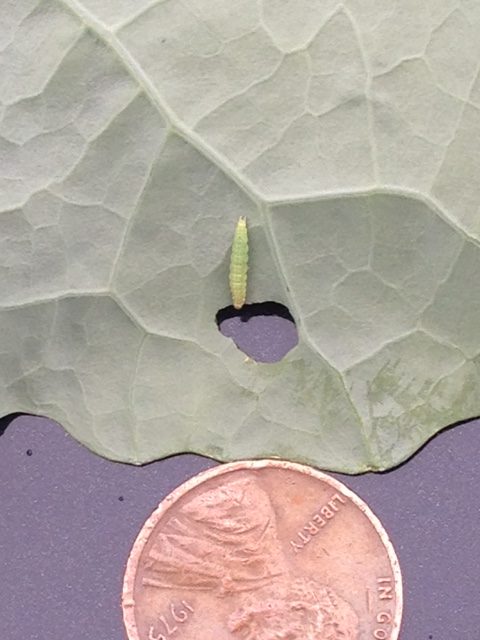 Diamondback moth larvae ((DBM) see photo at right) continue to be present in many cole crop plantings, along with imported cabbageworm, cabbage looper and cross-striped cabbage worm. DBM can multiply quickly, but cooler temperatures should slow reproduction now. It is apparent that DBM is not responding to chlorantraniliprole (Coragen) in many parts of the state. Effective materials continue to be IRAC 5 materials (spinosyns), other IRAC 28 products like Exirel, the IRAC 6 material, ememectin benzoate (Proclaim), and the carbamate (1A) Lannate. Lannate and Proclain have longer PHIs, so it is best to start with these if a DBM population is present. Transition to shorter PHI materials like the spinosyns or Exirel as harvest gets closer. Be sure to check the Cole Crops Section of the 2022-23 Commercial Guide for specifics, as PHI’s and crop labels vary. It is important to return to treated fields within 2-3 days to assess the efficacy of the insecticide applications. Effective materials should eliminate DBM larvae within 48 hours. Any insecticide that controls DBM will also be successful against the other larval species in the crop.
Diamondback moth larvae ((DBM) see photo at right) continue to be present in many cole crop plantings, along with imported cabbageworm, cabbage looper and cross-striped cabbage worm. DBM can multiply quickly, but cooler temperatures should slow reproduction now. It is apparent that DBM is not responding to chlorantraniliprole (Coragen) in many parts of the state. Effective materials continue to be IRAC 5 materials (spinosyns), other IRAC 28 products like Exirel, the IRAC 6 material, ememectin benzoate (Proclaim), and the carbamate (1A) Lannate. Lannate and Proclain have longer PHIs, so it is best to start with these if a DBM population is present. Transition to shorter PHI materials like the spinosyns or Exirel as harvest gets closer. Be sure to check the Cole Crops Section of the 2022-23 Commercial Guide for specifics, as PHI’s and crop labels vary. It is important to return to treated fields within 2-3 days to assess the efficacy of the insecticide applications. Effective materials should eliminate DBM larvae within 48 hours. Any insecticide that controls DBM will also be successful against the other larval species in the crop.
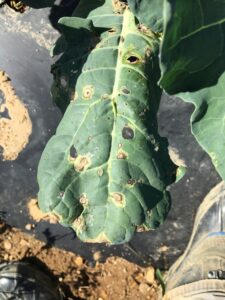 Alternaria is increasing, particularly in broccoli and cauliflower plantings. Rotation away from recent cole crop plantings is a particularly useful cultural control for this disease. Dispose of all residue after the crop’s useful life is over so that it doesn’t serve as a source for further infections. Useful fungicides for this disease may be found in the Cole Crops Section of the 2022-23 Commercial Guide.
Alternaria is increasing, particularly in broccoli and cauliflower plantings. Rotation away from recent cole crop plantings is a particularly useful cultural control for this disease. Dispose of all residue after the crop’s useful life is over so that it doesn’t serve as a source for further infections. Useful fungicides for this disease may be found in the Cole Crops Section of the 2022-23 Commercial Guide.
Allium leaf miner
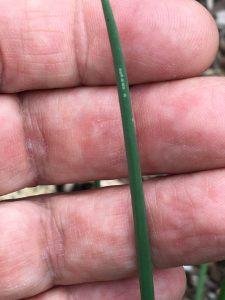 Allium leaf miner (photo of adult at right, feeding/egg laying scars at right) is now be active again in onion, leek, garlic and related crops, with feeding/egg laying scars present in a number of plantings. Row covers can be effective at limiting crop exposure to this pest, especially in organic situations where insecticide choices are limited.
Allium leaf miner (photo of adult at right, feeding/egg laying scars at right) is now be active again in onion, leek, garlic and related crops, with feeding/egg laying scars present in a number of plantings. Row covers can be effective at limiting crop exposure to this pest, especially in organic situations where insecticide choices are limited. 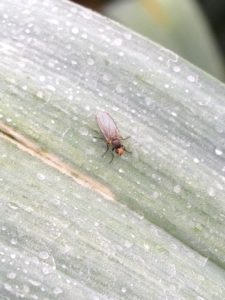
The second flight should last well into October. At this time, growers should protect all alliums either with row covers, or weekly insecticide applications. Insecticides recommended for ALM management include:
Spinosyn materials (Radiant, Entrust (OMRI approved)), pyrethroids (Mustang Maxx, Warrior), neonicotinoids (Scorpion, Venom) and the insect growth regulator Trigard are labeled for miner control. The diamide, Exirel, is permitted in NJ under a 2ee label as well.
